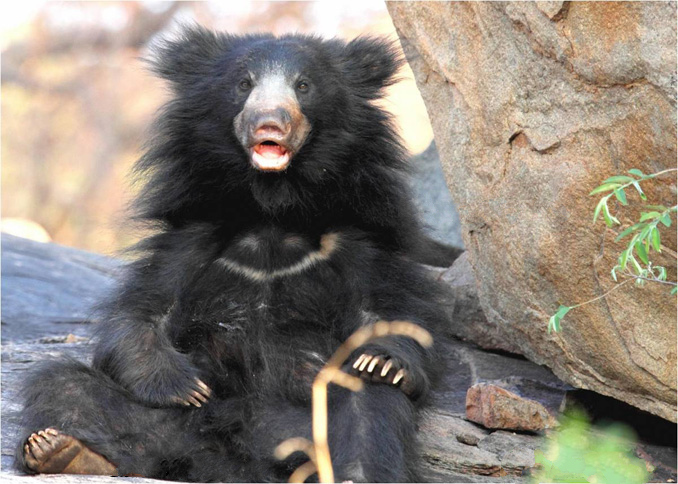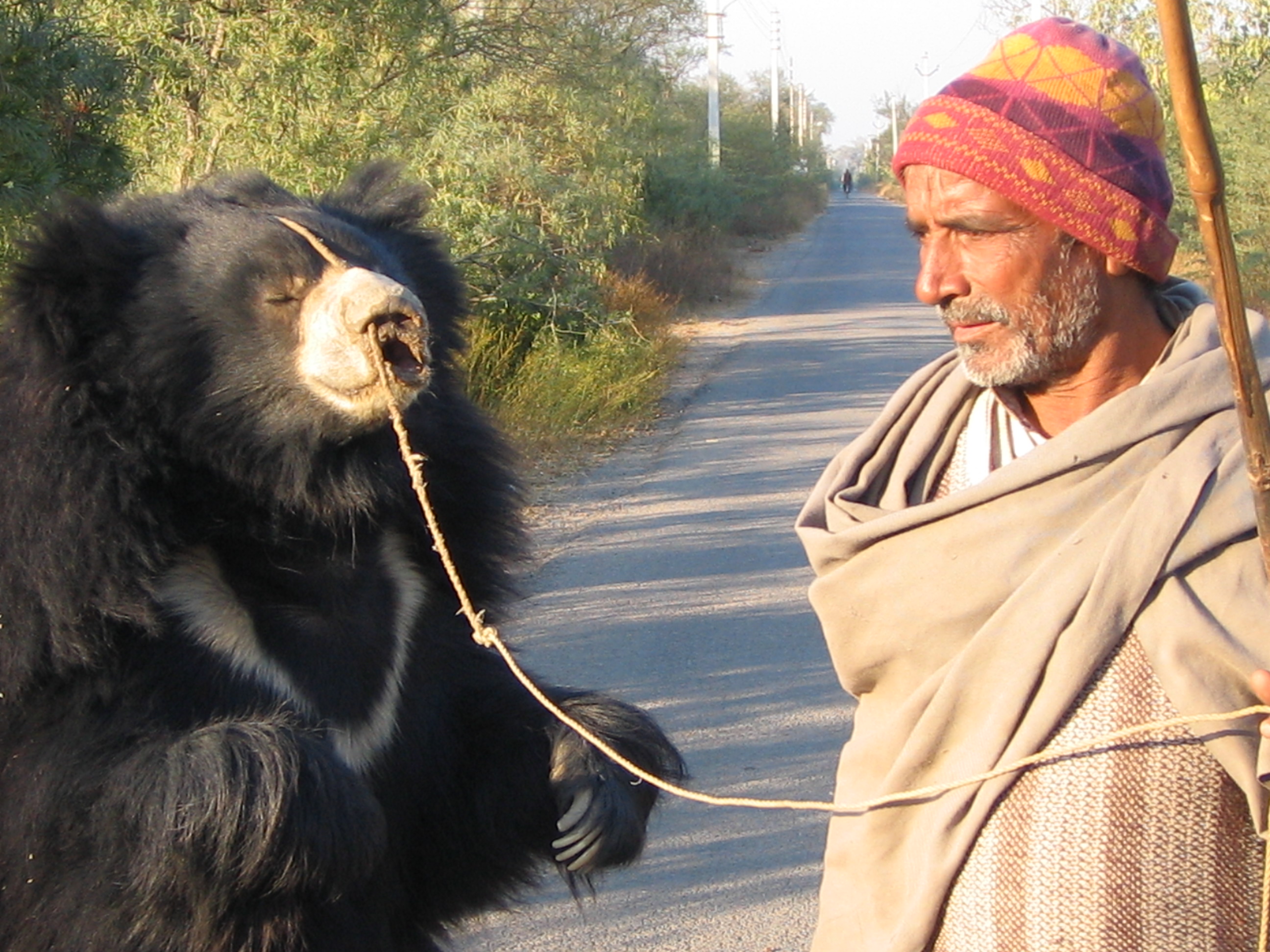Agra Bear Rescue Facility on:
[Wikipedia]
[Google]
[Amazon]
The Agra Bear Rescue Facility is a

 The
The
Sloth bear
The sloth bear (''Melursus ursinus'') is a myrmecophagous bear species native to the Indian subcontinent. It feeds on fruits, ants and termites. It is listed as Vulnerable species, vulnerable on the IUCN Red List, mainly because of habitat loss ...
rescue facility dedicated to rehabilitating previously enslaved 'dancing bear
A tame bear, often called a dancing bear, is a wild bear captured when young, or born and bred in captivity, and used to entertain people in streets or taverns. Dancing bears were commonplace throughout Europe and Asia from the Middle Ages to the ...
s'. Established in 1999 by Wildlife SOS
Wildlife SOS (WSOS) is a conservation non-profit organisation in India, established in 1995 with the primary objective of rescuing and rehabilitating wildlife in distress, and preserving India's natural heritage. It is currently one of the large ...
in collaboration with the Uttar Pradesh Forest Department and others, the facility is located in an eight-hectare site inside the Sur Sarovar Bird Sanctuary(also known as Keetham Lake), 17km west of Agra. It is one of the four facilities in India operated by Wildlife SOS for this purpose, and helped in the eradication of the ‘dancing bear’ practice in India. It currently houses over 170 sloth bears as well as other wildlife. Agra Bear Rescue Facility also does advanced research, disease management and provides specialised veterinary care as well as geriatric care
Gerontological nursing is the specialty of nursing pertaining to older adults. Gerontological nurses work in collaboration with older adults, their families, and communities to support healthy aging, maximum functioning, and quality of life. The ...
for sloth bears. The facility is available for tours by small groups of people.
History and Overview

 The
The sloth bear
The sloth bear (''Melursus ursinus'') is a myrmecophagous bear species native to the Indian subcontinent. It feeds on fruits, ants and termites. It is listed as Vulnerable species, vulnerable on the IUCN Red List, mainly because of habitat loss ...
(''Melurus ursinus'') is a medium-sized omnivorous
An omnivore () is an animal that has the ability to eat and survive on both plant and animal matter. Obtaining energy and nutrients from plant and animal matter, omnivores digest carbohydrates, protein, fat, and fiber, and metabolize the nutri ...
species of bear found in the Indian subcontinent, predominantly India, with a small population in Nepal and Bhutan, and a sub-species in Sri Lanka. It is listed as vulnerable on the IUCN Red list
The International Union for Conservation of Nature (IUCN) Red List of Threatened Species, also known as the IUCN Red List or Red Data Book, founded in 1964, is the world's most comprehensive inventory of the global conservation status of biol ...
.
For over 400 years, the Sloth Bear had been a target for human exploitation. A nomadic tribe
A nomad is a member of a community without fixed habitation who regularly moves to and from the same areas. Such groups include hunter-gatherers, pastoral nomads (owning livestock), tinkers and trader nomads. In the twentieth century, the pop ...
known as the Kalandars began keeping ‘dancing’ sloth bears which entertained Mughal emperors. Over the centuries, the ‘dancing’ bear trade transitioned to become cheap roadside entertainment for villagers and tourists who paid to watch the bears.
The practice of enslaving bears for use as 'dancing' bears has been illegal in India under the Wildlife Protection Act 1972.However this rule was not well enforced, and as a result hundreds of bears remained enslaved. The bears were poached from the forests as cubs, their mothers often killed, and sold in illegal markets to Kalandars, who have used the dancing bears as a source of income for centuries. With no anaesthesia
Anesthesia is a state of controlled, temporary loss of sensation or awareness that is induced for medical or veterinary purposes. It may include some or all of analgesia (relief from or prevention of pain), paralysis (muscle relaxation), am ...
, a metal rod would be inserted through their muzzle so that a rope or nose ring can be attached and they spent much of their lives in pain chained to a stake or in a cage. Their canine teeth were crudely knocked out, and the bears were beaten into submission to teach them to perform.
In 1996, Wildlife SOS's research indicated that there were more than 1200 ‘dancing’ bears scattered throughout India. In collaboration with the Uttar Pradesh Forest Department, International Animal Rescue
International Animal Rescue (IAR) is an Animal protectionism, animal protection and conservation non-profit organisation that comes to the aid of suffering animals with hands-on rescue and Wildlife rehabilitation, rehabilitation and the protecti ...
, One Voice, Free The Bears, and others, Wildlife SOS established the Agra Bear Rescue Facility to rehabilitate bears.
Bear rehabilitation process
On arrival to the facility, the rescued bears undergo a 90-day quarantine to prevent spread of any infectious disease to any other bear. Other immediate procedures include a complete health checkup where bears are treated for any diseases, wounds and parasites. The bear receives vaccination for many diseases likeRabies
Rabies is a viral disease that causes encephalitis in humans and other mammals. Early symptoms can include fever and tingling at the site of exposure. These symptoms are followed by one or more of the following symptoms: nausea, vomiting, vi ...
, Leptospirosis
Leptospirosis is a blood infection caused by the bacteria ''Leptospira''. Signs and symptoms can range from none to mild (headaches, muscle pains, and fevers) to severe ( bleeding in the lungs or meningitis). Weil's disease, the acute, severe ...
and infectious canine hepatitis
Infectious canine hepatitis (ICH) is an acute liver infection in dogs caused by ''Canine mastadenovirus A'', formerly called ''Canine adenovirus 1'' (CAV-1). CAV-1 also causes disease in wolves, coyotes, and bears, and encephalitis in foxes. The ...
. Once the quarantine period ends, the bears are encouraged to go into large socialisation enclosures with other bears where the behaviour and personality of each bear is monitored by Wildlife SOS staff.
After this process, the bear is matched to a group based on its personality, and then moved to a larger free-range area. The facility has full-time wildlife veterinary doctors and bear keepers. The bear hospital features a laboratory, along with X-ray
An X-ray, or, much less commonly, X-radiation, is a penetrating form of high-energy electromagnetic radiation. Most X-rays have a wavelength ranging from 10 picometers to 10 nanometers, corresponding to frequencies in the range 30&nb ...
, Ultrasound
Ultrasound is sound waves with frequency, frequencies higher than the upper audible limit of human hearing range, hearing. Ultrasound is not different from "normal" (audible) sound in its physical properties, except that humans cannot hea ...
, Dental suite, Operation theatre and other equipments. The facility also includes a special cub weaning area which is dedicated to foster rescued baby bears.
Because the bears have been captive most of their lives, its unlikely they can ever be released into the wild, but the goal of Wildlife SOS is to eradicate the practice of dancing bears which has been illegal in India since 1972 but still enslaves bears, and thus stop the poaching of cubs. An important part of this is finding an alternative source of income for the Kalandar tribespeople and educating them about the cruelty of their former profession. A number of young Kalandar men are even employed at the facility helping care for the bears.
Tours
The facility is available for tours, with a payment of entry fee to the Forest Department in order to access the facility, when last checked.{{Cite web, title=Agra Bear Rescue Facility {{! Agra, India Attractions, url=https://www.lonelyplanet.com/india/uttar-pradesh/agra/attractions/agra-bear-rescue-facility/a/poi-sig/1558945/356509, access-date=2020-10-06, website=Lonely Planet, language=enReferences